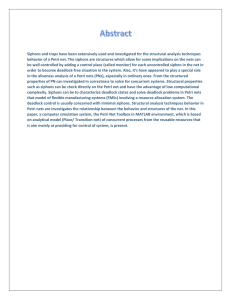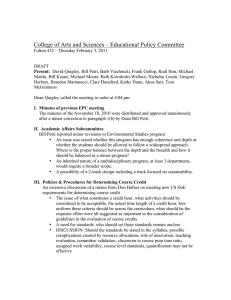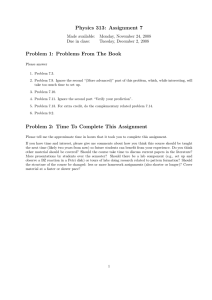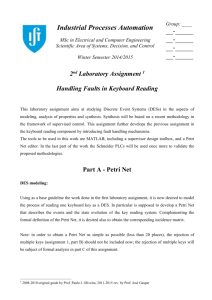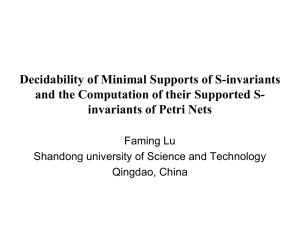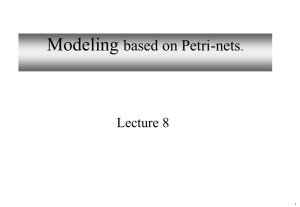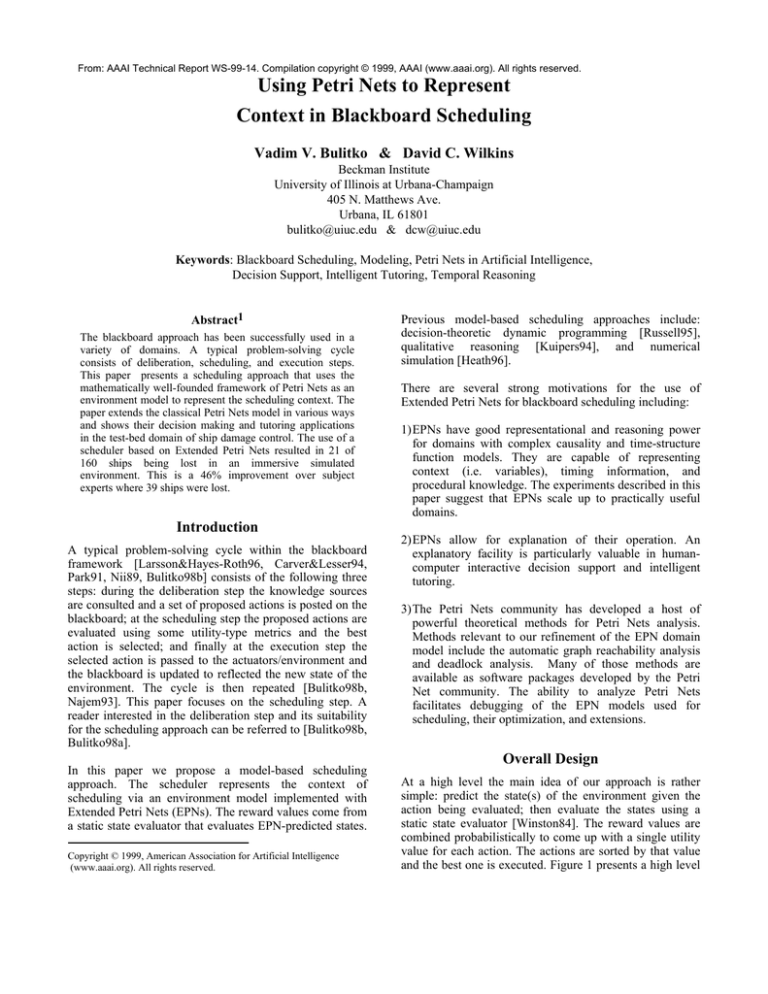
From: AAAI Technical Report WS-99-14. Compilation copyright © 1999, AAAI (www.aaai.org). All rights reserved.
Using Petri Nets to Represent
Context in Blackboard Scheduling
Vadim V. Bulitko & David C. Wilkins
Beckman Institute
University of Illinois at Urbana-Champaign
405 N. Matthews Ave.
Urbana, IL 61801
bulitko@uiuc.edu & dcw@uiuc.edu
Keywords: Blackboard Scheduling, Modeling, Petri Nets in Artificial Intelligence,
Decision Support, Intelligent Tutoring, Temporal Reasoning
Abstract1
The blackboard approach has been successfully used in a
variety of domains. A typical problem-solving cycle
consists of deliberation, scheduling, and execution steps.
This paper presents a scheduling approach that uses the
mathematically well-founded framework of Petri Nets as an
environment model to represent the scheduling context. The
paper extends the classical Petri Nets model in various ways
and shows their decision making and tutoring applications
in the test-bed domain of ship damage control. The use of a
scheduler based on Extended Petri Nets resulted in 21 of
160 ships being lost in an immersive simulated
environment. This is a 46% improvement over subject
experts where 39 ships were lost.
Previous model-based scheduling approaches include:
decision-theoretic dynamic programming [Russell95],
qualitative reasoning [Kuipers94], and numerical
simulation [Heath96].
There are several strong motivations for the use of
Extended Petri Nets for blackboard scheduling including:
1) EPNs have good representational and reasoning power
for domains with complex causality and time-structure
function models. They are capable of representing
context (i.e. variables), timing information, and
procedural knowledge. The experiments described in this
paper suggest that EPNs scale up to practically useful
domains.
Introduction
A typical problem-solving cycle within the blackboard
framework [Larsson&Hayes-Roth96, Carver&Lesser94,
Park91, Nii89, Bulitko98b] consists of the following three
steps: during the deliberation step the knowledge sources
are consulted and a set of proposed actions is posted on the
blackboard; at the scheduling step the proposed actions are
evaluated using some utility-type metrics and the best
action is selected; and finally at the execution step the
selected action is passed to the actuators/environment and
the blackboard is updated to reflected the new state of the
environment. The cycle is then repeated [Bulitko98b,
Najem93]. This paper focuses on the scheduling step. A
reader interested in the deliberation step and its suitability
for the scheduling approach can be referred to [Bulitko98b,
Bulitko98a].
In this paper we propose a model-based scheduling
approach. The scheduler represents the context of
scheduling via an environment model implemented with
Extended Petri Nets (EPNs). The reward values come from
a static state evaluator that evaluates EPN-predicted states.
Copyright © 1999, American Association for Artificial Intelligence
(www.aaai.org). All rights reserved.
2) EPNs allow for explanation of their operation. An
explanatory facility is particularly valuable in humancomputer interactive decision support and intelligent
tutoring.
3) The Petri Nets community has developed a host of
powerful theoretical methods for Petri Nets analysis.
Methods relevant to our refinement of the EPN domain
model include the automatic graph reachability analysis
and deadlock analysis. Many of those methods are
available as software packages developed by the Petri
Net community. The ability to analyze Petri Nets
facilitates debugging of the EPN models used for
scheduling, their optimization, and extensions.
Overall Design
At a high level the main idea of our approach is rather
simple: predict the state(s) of the environment given the
action being evaluated; then evaluate the states using a
static state evaluator [Winston84]. The reward values are
combined probabilistically to come up with a single utility
value for each action. The actions are sorted by that value
and the best one is executed. Figure 1 presents a high level
Extended Petri Nets
Petri Nets is a formalism proposed by C. A. Petri with
some early applications to modeling communication
protocols and distributed software systems [Murata89].
Petri Nets have traditionally been viewed as being best
suited for performance evaluation and communication
protocol analysis in the areas of distributed software,
database, and communication systems, programmable
logic and VLSI design, formal languages, and logic
programs [Murata89, Peterson81]. Later on higher-order
Petri Nets extended with color and time information have
been developed and applied to modeling and analysis of
complex real-world systems such as production plant
operations [vanderAalst94, vanderAalst93, Jensen92,
Merlin74, Merlin76]. Attractive properties of Petri Nets
include the solid and well developed mathematical
foundation, a number of theoretical and practical analysis
methods, and a great variety of supporting software
packages. Petri Nets continue to be widely used and there
strategy chains
new data
Scheduling
findings/hypotheses,
strategy chains
EPN prediction
state
evaluation
predicted ship states
ship state scores
Environment
predicted ship states
ship state scores
utilities
computation
action utilities
orders
rated actions
Execution
orders
Figure 1. Minerva-5 Operation: the blackboard
framework and problem-solving cycle stages
Predicted
Environment State
Severity of State
input 1
input n
severity 1
The Static Evaluator
...
The state evaluator is used as a “black box” that has
several inputs representing the state of the environment and
several outputs representing the severity of the state with
regard to the problem-solving tasks (Figure 2). In the testbed domain of ship damage control the environment is the
ship (either real or simulated) from a perspective of the
Damage Control Assistant (DCA). A DCA is the officer in
charge of handling crises aboard a ship. The DCA’s
functions include recognizing crises and properly
responding to them by giving orders to repair stations and
the like. Thus, the input of the state evaluator is a state of
the ship: status of compartments and vital equipment with
regard to fire, flood, etc. The output is severity of the ship
state and is proportional to the time till a predicted major
disaster (“time till kill point”) [Bulitko98a]. Artificial
neural networks [Haykin94] and decision trees [Quinlan86,
Quinlan93] are used as the internals of the “black box”.
Both have shown comparable performance on the data sets
that were used.
findings
Deliberation
Blackboard
Our approach is model-based [Russell95]. That is, unlike
Q-learning an explicit model of the environment is used.
An environment model has the following two main
functions: (1) it envisions the future states of the
environment given the current state and the action the
agent is about to take; and (2) it envisions the reward the
agent will get if it takes the action. While in decision
theory such a model is often represented as the transition
probability and reward functions, in our case the
environment is modeled as an Extended Petri Network
(EPN). The EPN itself does not contain any reward
information. The reward values come from a static state
evaluator [Bulitko98a].
are several periodic conference exclusively devoted to their
development [e.g. ICATPN-99].
...
operation of the Minerva-5 expert system that uses this
approach. Further details on Minerva-5 can be found in
[Bulitko98a].
severity m
Figure 2. Static state evaluator as a black-box with state
attributes as inputs and state severity values as outputs
This paper proposes a set of extensions for making Petri
Nets suitable for scheduling in Artificial Intelligence (AI)
systems. It also compares the proposed extensions to
related research with applications in “non-AI” domains.
Classical Petri Nets
This section will briefly present the classical Petri Nets
(also known as place-transition or PT-nets) following the
notation of [Peterson81]. A Petri Net (PN) C is a tuple
C=<P,T,I,O> where P is a set of places, T is a set of
transitions, I is a set of transition inputs, and O is a set of
transition outputs. A marking of Petri Net C is denoted by
µ and a marked Petri Net is referred to as M=<P,T,I,O,µ>.
A marking is an n-vector of natural numbers where n is the
number of places (n=|P|).
An example will demonstrate the workings of Petri Nets.
Consider a very simple Petri Net “Firefighting” shown in
Figure 3. The large circles represent places
P={“Compartment is engulfed” (p1), “Firefighting in
progress” (p2), and “Fire is out” (p3)}. There is a single
transition T={t1} (shown as a thick horizontal black line)
that has p1 and p2 as its input (enabling) places, and p3 as
its output place. Accordingly I={<t1,p1>, <t1,p2>} and
O={<t1,p3>}. Sets I and O are shown graphically as arcs
between the places and the transitions. As mentioned
above a marking assigns tokens to the places. In the Figure
3 tokens are represented as black dots inside the places.
<1,1,0> marking is shown.
A Petri Net marking represents a snapshot of a system
being modeled by the net. This example models the
process of fighting fire. The marking shown represents the
situation of the compartment being engulfed and fire being
fought. The transitions represent state changes. In the
example the single transition expresses the rule that if the
compartment is engulfed and the fire is being fought the
fire will be put out. A transition fires when all of its
enabling places have the appropriate number of tokens in
them. Each arc leading from a place to a transition requires
a presence of one token in the originating place. Firing a
transition removes all the enabling tokens from the
corresponding enabling places and adds tokens to the
output place. In our example, firing transition t1 would
result in marking <0,0,1> corresponding to empty places
p1, p2 and place p3 having one token (i.e. the fire is out).
Compartment is
engulfed
Firefighting in
progress
p1
p2
t1
p3
Fire is out
Figure 3. A Classical (PT) Petri
Net modeling extinguishing a fire
While being conceptually simple, Petri Nets can be used to
model a wide spectrum of systems (e.g. multi-agent
systems sharing resources, operating systems, etc.)
[Peterson81]. A number of Petri Nets-related theoretical
results have also been developed [Peterson81].
The Petri Net Extensions
While being a powerful and attractive modeling tool, the
classical Petri Nets lack several features helpful for
modeling complex real-time systems. The five limitations
of the classical Petri Nets the paper addresses are as
follows:
• Classical PNs are essentially propositional (i.e. they
have no variables or functions). Therefore the modeled
system is described in an attribute-value way. To
model a large system containing many similar
components would require replication of a number of
tokens. For example: if to extend the toy PN described
above to model more than one compartment (say N
similar compartments), would require replication of
the same network N times. Clearly such redundancy
will have adverse effects on PN performance in terms
of speed and space.
• Classical PNs represent evolution of a modeled system
as a sequence of states with instantaneous transitions.
So in a way, the dynamics are modeled by means of
situational calculus [Russell95]. While such
representation is adequate for certain models, there are
systems that require explicit time and duration
representation. In our toy PN example putting a fire
out takes no time at all. In reality the information
about duration of various transitions (such as putting
out a fire) is often critical. An alternative formalism,
event calculus [Russell95], represents events as
entities with explicit duration, beginning, and ending
times.
• There is no uncertainty support in classical PNs. The
entire state of the world is assumed to be specified
exactly. This is an unrealistic assumption in many
real-world domains.
• All the enabling places are positive in the sense that the
transition firing requires tokens to be there. It is
trickier to express a rule that has negation in it (e.g. No
“Firefighting” and “Engulfment” result in “Fire
Spread”). In fact, PT-nets are incapable of zero-testing
in the general case [Peterson81]. That fact reduces
their modeling power and causes application
inconveniences.
• Every time a transition fires all the enabling tokens are
withdrawn from the enabling places. This doesn’t
always correspond to the actual system behavior
where an attribute might result in a transition firing yet
the value of that attribute remains unchanged (e.g. the
place “Fire” should not loose its tokens when
transition “Fire Spread” fires). In classical PNs extra
arcs would be needed to just put withdrawn tokens
back in.
To address those concerns several extensions are made to
the classical PN model. The new formalism is hence called
Extended Petri Nets (EPNs). The extensions are then
illustrated with another simple example. The new toy
example (Figure 4) introduces an EPN modeling fire
spread. Related Petri Net extensions by other researchers
will be considered as the paper proceeds.
• In addition to a domain identifier each token now has a
time interval associated with it. Time intervals are of
form [tbeginning, tending] that represents our belief on
when an attribute acquired its value. Example: token
with domain identifier {<Room, 3-78-0-M>}, time
interval [3:12, 3:44] in place “Compartment is
engulfed” represents our belief that compartment 3-780-M became engulfed sometime between 3min 12sec
and 3min 44sec of the scenario time. Of course, if we
know the time precisely the beginning and ending
times will coincide. This extension allows to do
temporal reasoning explicitly. It also supports
reasoning under uncertainty as follows. If we consider
a timestamp of an event to be a random variable then
our time intervals translate into well-known N%
confidence intervals where N is close to 100% (e.g.
95%). Similar extensions were produced by other
researchers. Petri Nets extended in such way are
known as time or timed Petri Nets [e.g. van der
Aalst93, van der Aalst94]. However, while most
researchers timestamp their tokens, we mark each
token with a time interval that has timestamp as its
special case (i.e. when the ends coincide).
• Transitions are no longer instantaneous but have a delay
interval associated with each of them. Each transition t
has an associated delay interval [∆min,∆max]. A
translation to the probability theory can be done as
follows: if t’s delay ∆t is a random variable then
[∆min,∆max] is the N% confidence interval for ∆t (again
N is close to 100%). This extension brings us closer to
the event calculus as opposed to the situational
calculus. Again there are other researchers who have
used time intervals for the transitions. Merlin in
[Merlin74, Merlin76] has used time intervals to
represent minimal and maximal enabling times,
however the Petri Nets themselves were not coloured.
van der Aalst in [van der Aalst93] used transition
{<Room,3-370-0-E>}
[3:12, 3:44]
Compartment is
engulfed
Firefighting in
progress
~
• There is now support for context by making each token
bear an identifier. An identifier is a set of pairs
<type,value>. Example: a token with identifier
{<Room, 3-370-0-E>, <Station, “Repair Locker 5”>}
in place “Firefighting in progress” is interpreted as
“Repair Locker 5 fire fighters are fighting fire in room
3-370-0-E”.
This
extension
addresses
the
propositionality and lack of variables/context issue of
the classical PNs. Similar extensions have been
suggested by other authors under a common name of
colouring. In Coloured Petri Nets each token is
assigned a vector of colour values [van der Aalst93,
Jensen92]. Our approach is different in that we (1)
explicitly specify the type of each value in the
identifier and (2) do not require the colours of a token
belong to the colour set of the place the token is in.
delay intervals in his ITCPN (Interval Timed Coloured
Petri Nets). Our approach differs from ITCPN in that
we maintain the interval calculus throughout the
representation while ITCPN tokens are timestamped
(i.e. have a point-value time).
[5min, 7min]
Spread to neighbors
Figure 4. Extended Petri Net modeling fire spread
• New types of arcs are introduced. Those include:
♦ NOT-arcs (negation or inhibitory arcs) mandate that
a transition the arc leads to will not fire if there is a
corresponding token in the originating place (e.g.
the arc between place “Firefighting in progress” and
the transition in Figure 4);
♦ double-ended arcs do not withdraw tokens from
their enabling places (e.g. the arc between
“Compartment is engulfed” and the transition in
Figure 4);
♦ operator-arcs have arbitrary operators associated
with them. In Figure 4 the arc coming out of the
transition creates multiple tokens corresponding to
the compartment’s neighbors). Related work has
been reported in [Jensen92].
EPN Operation
In this section we step through a simple example showing
an EPN in action. We will start with the an EPN modeling
ignition. Figure 5 presents the initial configuration where
place “Flammable Materials” is filled with two tokens
labeled with compartment (room) names. Both tokens have
their time intervals set to [0:00,0:00] meaning that the
compartments have been flammable since the beginning of
scenario. The other enabling place is labeled “Ignition
Temperature” and contains compartments that have
reached a sufficiently high temperature. In step 0 that place
has no tokens in it meaning that all compartment are cool
enough. The two places are enabling places for the
“Ignition” transition representing the event of ignition. The
transition is labeled with the time delay interval.
{<Space,3-370-0-E>}
[0:00, 0:00]
Flammable
Materials
Ignition
Temperature
Scenario
Specification
Module
[0min, 2min]
Ignited
The output label of the transition is naturally labeled
“Ignited” representing a compartment being ignited.
In Step 1 a new token is posted in place “Ignition
Temperature”. However, the token has a label {<Space, 422-0-L>,[2:37,2:45]} indicating that the passageway 4-220-L got hot sometime between 2:37 and 2:45 scenario time.
This news has no effect on the subnet since the passageway
doesn’t contain flammable materials (as far as we are
aware).
Flammable
Materials
Ignition
Temperature
{<Space,3-78-0-M>}
[0:00, 0:00]
{<Space, 4-22-0-L>}
[2:37, 2:45]
{<Space,3-370-0-E>}
[5:33, 6:12]
[0min, 2min]
Ignition
{<Space,3-370-0-E>}
[5:33, 8:12]
State
Evaluator
Machine
Learning
Packages
actions
Figure 5. Step 0: the initial configuration
Environment:
simulated from the
first principles
new data
Ignition
{<Space,3-370-0-E>}
[0:00, 0:00]
EPN
Predictor
scen specs
{<Space,3-78-0-M>}
[0:00, 0:00]
Scheduler
Domain Expert
Figure 7. Designing a state evaluator: a number
of scenarios are being run with a “teacher” (i.e.
a human domain expert or another expert
system) and the environment states and the
agent’s actions are being logged and used to
train the static board evaluator.
The first step is to construct an EPN that represents the
physical causality and timings in the domain. The places
would typically correspond to states of the environment
and the transitions would reflect the state change
information and timings. The arcs represent the causality
information and procedural knowledge (through the
operators attached to them). This is currently the most
labor-intensive step since it is done by hand eliciting
knowledge from a domain expert. Automating this step is
an area of current research.
Ignited
Figure 6. Step 2: generator room gets ignited
In Step 2 the generator room 3-370-0-E gets hot and a new
token is posted in place “Ignition Temperature”. This time
the space labels match and the transition fires resulting a
token in place “Ignited” and reflecting upon the event of
generator room ignition (Figure 6).
There are several observations to make: (1) the enabling
places retained their tokens as the enabling arcs were
double-ended; (2) the time-interval of the new token got
affected by the delay interval of the transition.
Designing a EPN-based scheduler
In this section we will go through a possible process of
designing a system that uses EPNs for model-based
scheduling. An instantiation of this process for the ship
damage control domain is presented in the next section
together with the experimental results.
The second step is to design a state evaluator to work with
the EPN predictor. One of the important decisions to make
is the choice of state severity scale and state attributes.
Once those two are selected one can turn to designing the
evaluator’s internals. Our design decisions have been to
utilize a static state evaluator using artificial neural
networks or decision rules as the internals. Fortunately,
both formalisms allow for automated synthesis as follows.
A number of training traces can be collected (either off
actual or simulated system logs as shown in Figure 7. The
simulation could be done with some existing, possibly
slow, off-line simulator). Each state in the traces is to be
represented with the attributes chosen and to be annotated
with the severity values as per the severity metric chosen.
Finally the annotated traces could be used as the training
samples to synthesize the ANN or a decision tree.
Commercial packages could be used for this substep.
Once trained the system could be used as described in the
previous section and outlined in Figure 1. As demonstrated
in the experimental evaluation section the system trained in
corresponds to a high-level goal (e.g. process hypothesis,
findout finding, etc.). Example: action “fight fire in X”
might correspond to hypothesis “fire in compartment X”.
this manner can indeed outperform its teacher.
Experimental Evaluation
Minerva-5 has a handcoded EPN part of which is shown in
Figure 8. Each deliberated action is fed into the EPN to
assess utility of the action. Simply put, overall utility of an
action is the sum of its operational and goal utilities.
Operational utility is the difference between the value of
predicted ship state if the action is taken and the value of
predicted ship state of the action is not taken. Intuitively,
operational utility reflects how much good an action is
going to do us if taken now.
Implementation in Minerva-5
The EPN framework has been tested as a part of Minerva-5
blackboard expert system that has been written for the ship
damage control domain [Wilkins97]. Below is a
description of the EPN implementation within Minerva-5
while the most detailed treatment is given in [Bulitko98a].
The deliberation module of Minerva-5 generates a number
of feasible actions while solving a crisis. Each action
FINDINGS:
Hightemp
alarm
Fire boundaries
set
Flooding
Fire
Fire
fighting in
progress
Manned
and
ready
Exploding
compartments
ACTIONS:
Investigate
~
~
Firemain
~
~
~
~
~
Fire
pump
running
Fight
fire
ignition
fire
spread
extinguishing flooding
destruction explosion
start
investigation
start fire
fighting
Flood
Vital spaces
start
flooding
~
~
spread
fire
loosing
vital space
Investigation
complete
New
fire
Fire
out
Flooded
self
extinguishing
Compartment
destroyed
setting fire
boundaries
~
flooding
fire
Explosion
Vital space
lost
Setting fie
boundaries
Occupied
personnel
external
input
interface nodes:
report after
investigation
report after
setting fire
boundaries
report after
fighting fire
belongs to
the subnet
external to
the subnet
Figure 8. A fragment of Minerva-5's Extended Petri Net modeling fire-fighting activities including
physical phenomena and personnel effort
Goal utility reflects how important the goal, that the action
being evaluated is pursuing, is. It is defined as the
difference between the value of the predicted ship state
assuming that the goal hypothesis holds and the value of
the predicted ship state assuming it doesn’t hold.
Examples: operational utility of action “investigate
compartment for fire” is low since it doesn’t improve state
of the ship, however, it is goal utility is high since a
[potential] fire is an important issue. On the other hand,
action “fight fire” will have both operational and goal
utilities high.
lost. And it is a 46% improvement over Navy officers
where 39 ships were lost.
We limited the lookahead to 10 minutes. In other words,
anything predicted further into the future would be
ignored. The output of the EPN was fed into a state
evaluator. The single top-ranked action was carried out.
Following the design process outlined in the previous
section we had first handcoded an EPN to model fire and
flood related phenomena that take place aboard a DDG-51
class destroyer. We had then used Minerva-4 equipped
with a handcoded rule-based scheduler [Bulitko98b] to run
damage control scenarios automatically and collect the
training data. The training data was used to generate a
decision rule board evaluator using C5.0 package. The
scenarios were run within the DC-Train ship damage
control simulator used at the Surface Warfare Officer
School (SWOS) in Newport, R. I.
DC-Train 1.0 Runs. To evaluate the performance 500
scenarios have been run within the DC-Train ship damage
control simulator routinely we developed that is used at the
Navy officers school in Newport, R. I. We have then
compared Minerva-5 using the EPN scheduler to Minerva4 that had a handcoded context-free rule-based scheduler
[Bulitko98b] and to Navy officers at SWOS. The results
are presented in Figure 9.
140
110
120
117
93
100
80
60
39
40
28
22
21
22
Applications
In our research we have investigated applications of
Extended Petri Networks to human-computer collaborative
decision-making systems and intelligent tutoring systems.
While a detailed discussion could be found elsewhere
[Bulitko99a], we will present the highlights below.
Problem-solving. EPNs could be used for problem-solving
as a part of a blackboard based decision-making system.
The previous section has described one such deployed
application, Minerva-5. The attained problem-solving
expertise could be used as the basis for the following
functions.
Advising facilities allow an expert system, such as
Minerva-5, to explain its motivation for the actions taken.
Both blackboard deliberation and EPNs allow for natural
language output. Details could be found in [Bulitko98a].
Minerva-5 is equipped with a graphical user interface
(GUI) presenting the user with graphical and natural
language output [Bulitko99b].
Critiquing facilities use differential analysis as the basis.
Creative user’s actions that don’t have a match in the
expert system line of reasoning are fed into the EPN
predictor for evaluation. Again, Minerva-5 is equipped
with a critiquing GUI [Bulitko99a, Bulitko99b,
Bulitko98a]. Critiquing naturally relates to performance
scoring insomuch as every user action could be assigned an
explainable score. A scoring package has been developed
for Minerva-5 and deployed at a Navy training school at
Newport, R.I.
28
20
Related Work in Scheduling
0
Ship Lost
Ship Possibly Saved
Navy Officers
Minerva-4
Ship Saved
Minerva-5
Figure 9. Minerva-5 (EPN-based scheduler) vs.
Minerva-4 (context-free rule-based scheduler) vs. Navy
officers experimental comparison
Any scenario could have had one of the three outcomes:
“ship lost” meaning that a kill point was reached (i.e. a
major disaster such as a missile compartment explosion);
“ship possibly saved” meaning that at 25 minutes scenario
time the ship was still alive yet there were active crises;
and “ship saved” means there were no active crises at the
25-minute mark.
The use of the EPN based scheduler resulted in 21 ships
being lost. This is a 25% improvement over the use of a
handcoded rule-based scheduler wherein 28 ships were
Model-based Approaches
Three alternative model-based approaches that we
considered are dynamic programming, numerical
simulation, and quantitative reasoning. We will discuss
each of these in turn.
A dynamic programming formulation of a scheduling
problem explicitly represents all the states, and can
typically manage problems with in the order of 50,000
states [Dietterich98, Mitchell97, Russell95]. This method
is not suitable for the blackboard scheduling problem
associated with the ship damage control decision making
task because there are on the order of 101000 states in our
current test-bed system.
Numerical simulation methods [Heath96] can explicitly
model an environment by simulating it from first-
principles. Minerva-5 works in conjunction with a
numerical simulator for training the decision making
system, but it can't be used for scheduling because it is
approximately three orders of magnitude too slow.
definitely of help. The research has been supported in part
by ONR Grant N00014-95-1-0749, ARL Grant DAAL0196-2-0003, and NRL Contract N00014-97-C-2061.
Qualitative Reasoning methods [Kuipers94] are another
major method of explicitly modeling a complex
environment. Their major strength is the ability to simulate
a domain qualitatively. Extended Petri Nets have been
found to be useful because the ship damage control domain
requires simulation of a lot of quantitative and qualitative
processes. And the analysis tools that are possible because
of the strong mathematical foundation of Petri Nets, such
as reachability analysis and deadlock analysis, led us to
explore the use of Petri Nets.
References
Discussion
This paper has presented the formalism of Extended Petri
Nets that was created for the Blackboard scheduling
domain. An EPN-based scheduler should be able to be
used as an environment model in a variety of systems.
Combined with a state evaluator it provides both
envisioned states and associated rewards. Another main
contribution of the research is applying the approach in a
proof-of-the-principle domain of ship damage control. The
system has been deployed and routinely used at a Navy
training school for automated intelligent tutoring.
The proposed approach has a number of strengths
including high prediction speed, variable lookahead time,
and well-studied formalism of Petri Nets. It also opens a
number of directions for future research as follows.
Future Research Directions
Now that Petri Nets have been shown to be a useful
formalism for Blackboard scheduling, an area of future
research is to more deeply explore their relationship to
network representations that have been more heavily used
in AI, and to see the extent that the benefits can be
combined or lead to cross-fertilization.
One particular direction that we are currently exploring is
Learning EPNs. Currently the Extended Petri Networks are
manually designed. While being a reasonable approach in
some domains, handcoding might be too costly in other
domains. The consistency might become an issue as well.
This branch of research can take advantage of machine
learning methods to automatically extract the training data
and generate the EPNs based on it.
Acknowledgements
Sebastian Magda has done most of the EPN coding and has
contributed several interesting suggestions. Discussion
with KBS members and Dr. Valeriy K. Bulitko was
van der Aalst, W.M.P. 1993. Interval Timed Coloured Petri
Nets and their Analysis. In M. Ajmone Marsan editor,
Application and Theory of Petri Nets, volume 691 of
Lecture Notes in Computer Science, pp. 453 - 472.
Springer-Verlag, Berlin.
van der Aalst, W.M.P. 1994. Putting Petri nets to work in
industry. Computers in Industry, 25(1):45--54.
Bulitko, V. 1998a. Minerva-5: A Multifunctional Dynamic
Expert System. MS Thesis. Department of Computer
Science, University of Illinois at Urbana-Champaign.
Bulitko, V.; Wilkins, D.C. 1998b. Minerva: A Blackboard
Expert System for Real-Time Problem-Solving and
Critiquing.
Tech.
Report
UIUC-BI-KBS-98-003,
University of Illinois at Urbana-Champaign.
Bulitko, V.; Wilkins. D.C. 1999a. Automated Instructor
Assistant for Ship Damage Control. In the Proceedings of
The Eleventh IAAI Conference (accepted for publication).
Bulitko, V.; Wilkins. D.C. 1999b. Minerva-DCA: An
Intelligent Agent for Ship Damage Control. Proceedings of
the PACLP’99 conference (accepted for publication).
Carver, N.; Lesser, V. 1994. The Evolution of Blackboard
Control Architectures. In Expert Systems with
Applications--Special Issue on the Blackboard Paradigm
and Its Application, Volume 7, Number 1, pp. 1-30,
Liebowitz. New York, Pergamon Press.
Dietterich, T. 1998. The MAXQ Method for Hierarchical
Reinforcement Learning. In Proceedings of ICML'98
conference.
Donoho, S. 1993. Similarity-based learning for recursive
heuristic classification. Master’s thesis. University of
Illinois at Urbana-Champaign.
Haykin, S. 1994. Neural Networks: A Comprehensive
Foundation. Macmillan College Publishing Company.
Heath, M. 1996. Scientific Computing: An Introductory
Survey. McGraw Hill Text.
Jensen, K. 1992. Coloured Petri Nets. Basic Concepts,
Analysis Methods and Practical Use. Volume 1, Basic
Concepts. Monographs in Theoretical Computer Science,
Springer-Verlag.
Kuipers, B. 1994. Qualitative Reasoning. The MIT Press.
Larsson, E.; Hayes-Roth, B.; Gaba, D. 1996. Guardian:
Final Evaluation. Knowledge Systems Lab, Stanford
University. TechReport KSL-96-25.
Merlin, P. 1974. A Study of Recoverability of Computer
Systems. Ph.D. Thesis. University of California, Irvine.
Merlin, P.; Faber, D.J. 1976. Recoverability of
Communication Protocols. IEEE Transactions on
Communication, 24, pp. 1036-1043.
Mitchell, T. 1997. Machine Learning. WCB/McGraw-Hill.
Murata, T. 1989. Petri Nets: Properties, Analysis, and
Applications, in the proceedings of the IEEE 77, 541-580.
Najem, Z.H. 1993. A Hierarchical Representation of
Control Knowledge For A Heuristic Classification Shell.
Ph.D. Thesis. Department of Computer Science. University
of Illinois at Urbana-Champaign.
Barr, A.; Cohen, P.R.; Feigenbaum, E.A. eds. 1989. The
Handbook of Artificial Intelligence. Volume IV, Chapter
XVI by Nii, H.P. Addison-Wesley.
Quinlan, J.R. 1986. Induction of Decision Trees. Machine
Learning. 1(1), 81-106.
Quinlan, J.R. 1993. C4.5: Programs for Machine
Learning, San Mateo, California: Morgan Kaufmann.
Park, Y.T; Tan, K.W.; Wilkins, D.C. 1991. Minerva 3.0: A
Knowledge-based Expert System Shell with Declarative
Representation and Flexible Control. UIUC, Department of
Computer Science.
Peterson, J.L. 1981. Petri Nets Theory and Modeling of
Systems. Prentice-Hall, Inc.
Russell, S.; Norvig, P. 1995. Artificial Intelligence: A
Modern Approach. Prentice-Hall, Inc.
Wilkins, D.C.; Sniezek, J.A. 1997. An Approach to
Automated Situation Awareness for Ship Damage Control.
KBS Tech. Report UIUC-BI-KBS-97-012. Beckman
Institute. University of Illinois at Urbana-Champaign.
Winston, P.H. 1984. Artificial Intelligence. The second
edition. Addison-Wesley Publishing Company.
The International Conference on Application and Theory
of Petri Nets. The 20th annual meeting will be held in June
1999.

